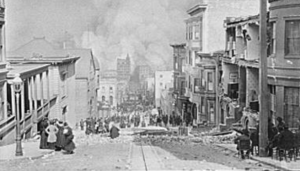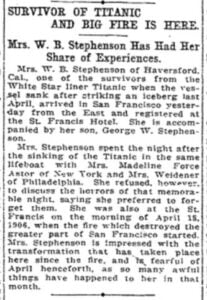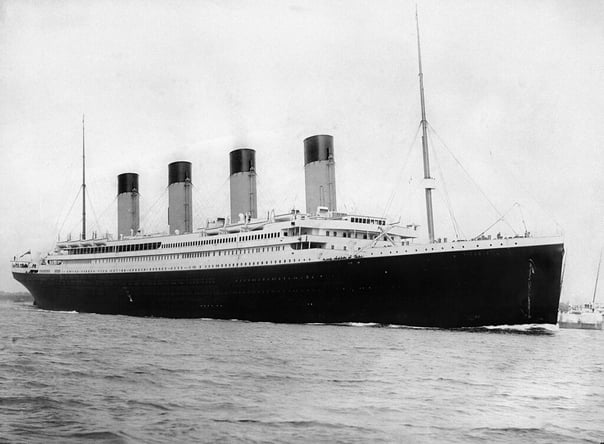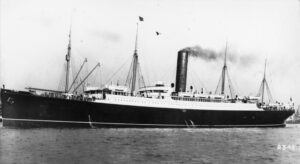 The fire after the 1906 San Francisco earthquake. Photo by Arnold Genthe, courtesy of the Library of Congress
The fire after the 1906 San Francisco earthquake. Photo by Arnold Genthe, courtesy of the Library of Congress
After my parents were married, my maternal grandmother[1] gave my mother a dowry of a kind, one suited to her new life in New England: the gift of Boston cousins. My mother’s family was both Southern in background and, given my grandfather’s service in the Navy, coastal by experience, so the notion that my mother had Glidden cousins in Boston appealed to her. As it happens, other than her grandmother’s family in Baltimore, the sprawling Glidden family (originally from Maine) makes up the largest part of my mother’s near kin.
My great-great-grandfather[2] was born in Newcastle, Maine, one of a large family where the daughters tended to marry seas captains and the sons – two of them, anyway – moved away to Cleveland, Ohio. My great-grandfather[3] followed his job to Baltimore, where my great-grandmother kept him; my maternal grandparents met in Annapolis, while my grandfather was at the Naval Academy – all in all, a notably American progression.
So it’s not surprising that some of the Glidden cousins ended up, independently, in Baltimore as well as Boston.[4] During my childhood, my mother talked about these cousins in enough detail that, when I came to research the descendants of my Glidden great-great-great-great-grandparents,[5] I found that her information – and, evidently, her mother’s information – was extremely accurate.
While working on Jeff Record’s recent piece on Jimmie Lefurgey as well as Pamela Athearn Filbert’s post on family diaries and letters, I was reminded of a curious kinship-by-extension through these Glidden cousins to Martha Eustis Stephenson, who survived both the San Francisco earthquake and the sinking of the Titanic.
*
 Martha Eustis (1860-1934) was a daughter of William Tracy Eustis and Martha Gilbert Dutton of Boston. According to the Encyclopedia Titanica, her father at one time worked for Sturtevant, Barker, and Athearn, oil dealers,[6] and her maternal grandfather was a founder of The Boston Evening Transcript.[7] In 1883, Martha married Walter Bryant Stephenson, with whom she later lived in Pennsylvania. George Eustis Stephenson, who married my mother’s cousin, was the only son; there were two older daughters.
Martha Eustis (1860-1934) was a daughter of William Tracy Eustis and Martha Gilbert Dutton of Boston. According to the Encyclopedia Titanica, her father at one time worked for Sturtevant, Barker, and Athearn, oil dealers,[6] and her maternal grandfather was a founder of The Boston Evening Transcript.[7] In 1883, Martha married Walter Bryant Stephenson, with whom she later lived in Pennsylvania. George Eustis Stephenson, who married my mother’s cousin, was the only son; there were two older daughters.
The San Francisco earthquake of 18 April 1906 would be enough of a catastrophe to shape the rest of one’s life, but evidently Mrs. Stephenson didn’t have much to say about it when she returned to San Francisco in August 1912 and checked in (as before) at the St. Francis Hotel. A local newspaper reported that “Mrs. Stephenson is impressed with the transformation that has taken place here since the [earthquake and ensuing] fire, and [she] is fearful of April henceforth, as so many awful things have happened to her in that month.”[8]
Her experience of the 1906 earthquake shaped her approach to the Titanic six years later. With her older sister, Elizabeth Mussey Eustis (1858-1936), Mrs. Stephenson was a first class passenger on the Titanic, boarding at Cherbourg after a winter in Europe. A resident of Haverford, Pennsylvania, Mrs. Stephenson gravitated to her Main Line neighbors, Mr. and Mrs. John B. Thayer[9] and Mrs. George D. Widener.[10] In the account the Eustis sisters wrote about their experience – The Titanic: Our Story – they record a pleasant passage through Sunday, 14 April (“neither of us had one bit of discomfort from sea sickness”); when Mrs. Stephenson borrows Sir Ernest Shackleton’s book on the South Pole and looks at pictures of “icebergs and ice fields,” she hardly imagines “she should ever see similar ones.”
Mrs. Stephenson was already asleep at 11:45 on Sunday night when she was awakened by a “terrible jar with ripping and cutting noise[s].” What to do? The D deck steward was dismissive, but other passengers dressed to see the ice fall. Elizabeth was surprised when Martha decided to dress “fully as if for breakfast.” Mrs. Stephenson strikes one as a fairly cool customer, but here she confronts her fear and replies “I should feel much safer with my clothes on and could go to bed later if all was right.” They don’t rush: “While Elizabeth was doing her hair the ship suddenly settled, frightening me very much, and I urged her not to take pains but to hurry.”
By the time they left their cabin they were indeed suitably dressed for the night ahead of them, but still the atmosphere was far from electric. Just as they were meeting their friends the Thayers on deck, all the passengers were ordered back to their rooms for life preservers. The sisters put the life vests on over their fur coats, and “we each took our steamer rugs, not knowing why, but simply that we were there.”
“My mind is a blank as to a trip we took to the boat deck…”
Soon the order came for men and women to separate, and the Eustis sisters held hands as they climbed up to the forward boat deck, “which on the Titanic, was the captain’s bridge.”
“As we leaned against the walls of the officers’ quarters[,] rockets were being fired over our heads, which was most alarming, as we fully realized if Titanic had used her wireless to ill effect and was sending rockets it must be serious.”
The women were sent to one of the lifeboats, where they encountered John Jacob Astor,[11] one of the most famous casualties of the disaster. When he tried to assist his pregnant wife, he was ordered back: “on being told again that no men could go [in Lifeboat 4], he called ‘Good bye’ and said he would follow in another boat…”
Theirs was the last lifeboat on the port side to be lowered. No one seemed to know how to work the release, and Mrs. Stephenson – noting there was water on the D deck (“the ports were square instead of round”) – writes that “My fear here was great, as she seemed to be going faster and faster, and I dreaded lest we be drawn in before we could cast off.”
“[We] all implored them to pull for our lives to get out from the suction when she should go down.”
“The lights on the ship burned till just before she went. When the call came that she was going I covered my face and then heard someone call ‘She’s broken.’ After what seemed a long time I turned my head only to see the stern almost perpendicular in the air so that the full outline of the blades of the propeller showed above the water. She then gave her final plunge and the air was filled with cries…”
Those first moments were nightmarish, and tragic choices were made: “We could only take a few [off a capsized lifeboat] and they had to come very cautiously. The other boat took most of the men and we then rowed away, the cries soon ceasing.”
It was at six in the morning that Lifeboat 4 reached its rescuer, the Carpathia; using a boatswain’s chair, the survivors were lifted to an open hatch. Once onboard they found Mrs. Thayer’s son Jack.[12] With a friend, he had jumped as the ship went under: “After being sucked under twice he swam for the overturned boat, was pushed back into the water [by other survivors?], finally finding a place and sitting there until rescued.”
Looking out from the Carpathia, Mrs. Stephenson saw scenes from Shackleton’s book: “The entire horizon for the complete circle had bergs stationed like sentinels.”
The scenes in New York were appalling, with reporters in a frenzy to interview survivors: “A sudden rush of water frightened us, but on inquiry we discovered that Captain Rostron had turned the hose on [one of the tugs] and she was scurrying off at full speed and I trust the men were well soaked.”
The sisters separated, Elizabeth to spend the night in New York before returning to Boston, Mrs. Stephenson traveling by special train to North Philadelphia: “Joseph met us with the motor and we got to Haverford a little after three in the morning.”
Notes
[1] Pauline Glidden (1903-1968) married Ensign Frederick Jackson Bell in 1925.
[2] William Pierce Harrington Glidden (1830-1913) married Jane Letitia Hughes in 1871.
[3] Edward Hughes Glidden (1873-1924) married Pauline Boucher in 1899.
[4] Descendants of William P. H. Glidden’s sister Mary Myrick (Glidden) Joy, whose daughter Sarah married Dr. Robert Brewer Dixon in 1882; it was the Dixons’ daughter, my grandmother’s second cousin Louise Dixon, who married George Eustis Stephenson in 1915.
[5] Joseph Glidden (1757-1816) married Mary Waters in 1781.
[6] The Athearn in the company name was, in fact, Pamela’s great-great-great-grandfather, James Frederick Athearn.
[7] Cornelia Wells Walter, who succeeded her brother as the Transcript’s editor, figures in the Gray diary as Mrs. William Bordman Richards.
[8] San Francisco Chronicle, 17 August 1912, 12.
[9] John Borland Thayer (1862-1912) married Marian Longstreth Morris in 1893.
[10] Eleanor Elkins (1861-1937) was married to George Dunton Widener 1883-1912 and to Alexander Hamilton Rice Jr. in 1915.
[11] Colonel John Jacob Astor (1864-1912) was married to Ava Lowle Willing 1891-1909 and to Madeleine Talmage Force in 1911.
[12] John Borland Thayer II (1894-1945) married Lois Buchanan Cassatt in 1917.
Share this:
About Scott C. Steward
Scott C. Steward has been NEHGS’ Editor-in-Chief since 2013. He is the author, co-author, or editor of genealogies of the Ayer, Le Roy, Lowell, Saltonstall, Thorndike, and Winthrop families. His articles have appeared in The New England Historical and Genealogical Register, NEXUS, New England Ancestors, American Ancestors, and The Pennsylvania Genealogical Magazine, and he has written book reviews for the Register, The New York Genealogical and Biographical Record, and the National Genealogical Society Quarterly.View all posts by Scott C. Steward →

